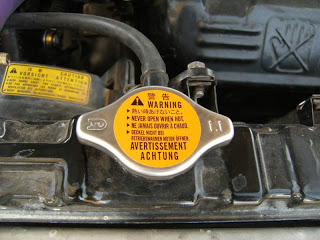

The part of the vehicle called “radiator cover” contains 2 valves. Its purpose is to store the coolant and ensure that the radiator system remains under pressure. The inside of the cooler contains 16 pounds of pressure per square inch. This pressure is controlled by the radiator cap and must remain constant. Otherwise, your car could overheat and the radiator could suffer serious damage. You will find more information on the radiator cap below.
Signs of a defective radiator cap

Some signs will tell you if your radiator cap is broken. Here are the top 5 signs.
1.
Leaking coolant
If the radiator cap is stuck, no liquid can be released. This creates pressure in the radiator, causing the hose to leak or break. If you notice coolant near the radiator or its cap, the coolant flows clearly. Check if the radiator has holes or if the plug is worn or damaged. If so, replace the cap.
2.
Overflowing tank
Coolant enters the tank as it expands. The radiator cap is released by the pressure and the coolant is directed into the overflow tank. If the radiator cap is broken, the coolant will be released too quickly and the boat will overflow.
3.
The radiator pipe collapses
The radiator cap may be defective if the radiator hose collapses. The radiator cap does not release the vacuum properly and the radiator pipe collapses during the cooling phase. If this happens, check the cap for damage. If so, replace it immediately.
4.
Air in the cooling system
If the radiator cap does not close properly, air will enter the refrigeration system. Air pockets enter the radiator, thermostat and radiator. As a result, the engine overheats because it can not withstand a constant temperature.
5.
Overheated engine
Leakage of coolant or air in the cooling system may cause the engine to overheat. If you notice that your engine is heating up too much, do not look under the hood unless you have turned off the engine. This allows the engine to stay cool during the check. If there is coolant near the radiator cap, the pressure cap may be damaged. Check this and replace it if necessary.
Inspect the radiator cap
If you have a radiator pressure tester, you can check the radiator cap yourself. Start by opening the hood and locate the radiator. It should be located directly in front of the vehicle engine. Now, remove the radiator cap by pushing it in and then turning it counterclockwise. Take the plug adapter and screw it to the end of the pressure tester. Keep turning until you can not screw it. If you do not know what the cap adapter looks like, check the label on the pressure tester package and see if it is displayed on it. You can as well do a research work on the Internet. After attaching the plug adapter to the pressure tester, remove the radiator cap and screw it to the other end of the tester until it is securely in place

SPONSORED LINKS
[TRENDING SONG!!] Romani D-Fans – Bestie (Prod By Krizbeatz)
[TRENDING MIXTAPE!!] DJ Baddo – Bestie Unlimited Mix
[TRENDING SONG!!] TYSG Ft Bad Mz X Kendi Rozzi – Iyariya
INSTALL 9JAFLAVER MUSIC APP, STREAM, DOWNLOAD, AND PLAY MUSIC OFFLINE
CHECK OUT FUNNY PICTURE AND MEME HERE (CLICK HERE)
Chissom Anthony – Glory To God In The Highest [See Trending Gospel Song]
© 2014-2023 9jaflaver. All Rights Reserved.
About us | DMCA | Privacy Policy | Contact us
| Advertise| Request For Music | Terms Of Service
9jaflaver is not responsible for the content of external sites.